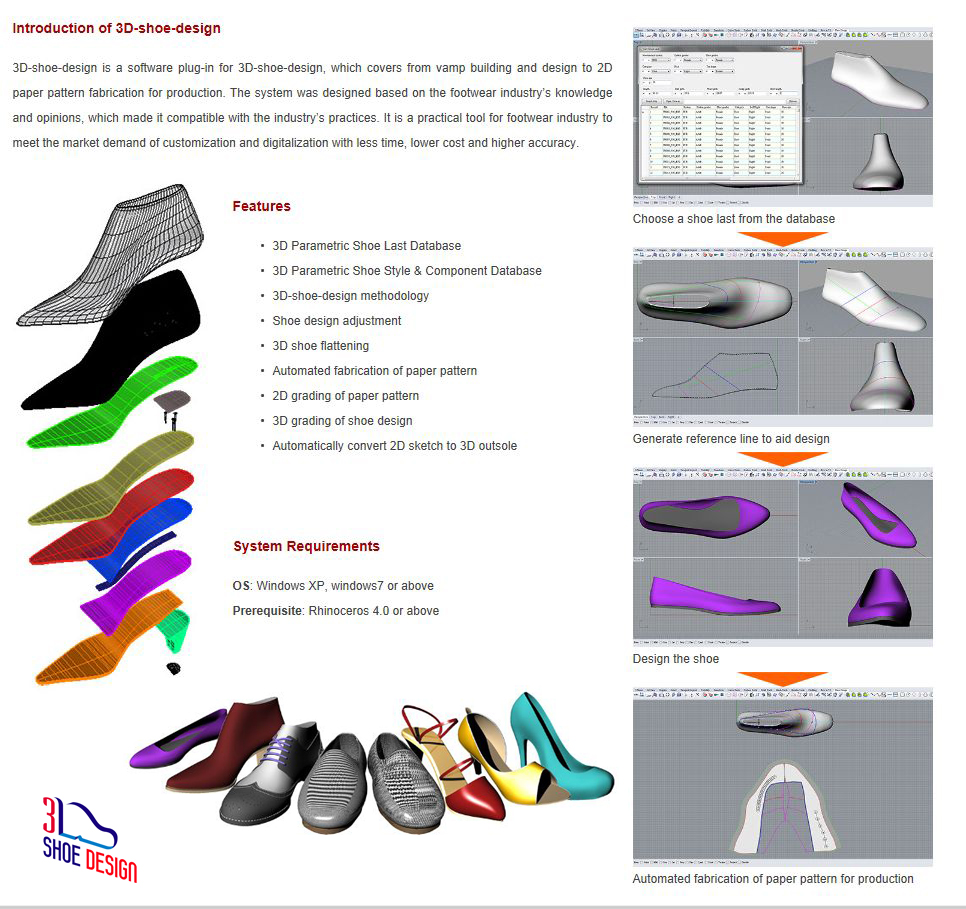Shoeware 3D Design Software II
In light of the aging population in Hong Kong, the demand for elderly shoes has been increasing. Unfortunately, most of the elderly shoes available in the market are over-designed with too soft materials, too thick soles or too wide toe and thus they fail to alleviate associated problems of aging feet. The footwear industry is lack of such design guidelines and the relevant testing standards for producing high quality ergonomics elderly shoes.
This phase II project will enhance the knowledge base shoes design system for lady’s footwear developed in the phase I project (ITP/037/12TP) to assist shoes designers to enter the growing market of elderly shoes. The testing standard and correlations among shoes parameters, shapes, materials and aging feet will be investigated, such that the optimal combinations of insole, outsole and shoes design will be found and included in the proposed design guidelines for shoes designers to create ergonomics elderly shoes that can alleviate the associated problem of aging feet.
The software contains a 3D database of 400 common shoe lasts. Users can retrieve the built-in shoe lasts entry or add their own shoe last data for design. While freeform is the most difficult features to be fabricated in CAD, this system formulates a mechanism to help designers build a freeform vamp accurately and easily based on the shoe last. This significantly reduces the difficulty and time to construct 3D shoe models.
Designers can design shoe line, shape and patterns according to the reference line on the vamp. When the design completes, users can apply 3D shoe flattening function to fabricate the paper pattern. 2D and 3D grading functions of the add-on software allow fabrication of multiple size paper pattern at a time, which saves more time than traditional process. Besides, the 3D file is compatible to CAM cutting machines, this can speed up the production process.
Most footwear manufacturers still adopt manual approach to measure shoe last and fabricate shoe’s paper pattern, which is time-consuming, expensive and inaccurate due to human error. Once the design is made into paper pattern, changes on dimensions and design will cause craftsmen a lot of time to redo or revise the paper pattern, the process will slow down the production cycle.
With 3D CAD software, designers can quickly amend the paper pattern, hence reducing cycle time and production cost. Besides, the software can indicate the shoe parameters accurately, together with the aid of computerised cutting machine, the inconsistency of paper pattern brought by human error in drawing and cutting could be greatly reduced. Although professional 3D footwear design software is available in the existing market, the acquisition cost is high. It is difficult for SMEs to bear the risk. This plug-in software can help them adopt 3D design tools at a lower cost.
With inadequate knowledge on 3D CAD software, local footwear designers seldom make use of its general features to draw the desire product. This has hindered them from the application of 3D CAD software.
However, the software is especially suitable for making complicated 3D drawing which the vamps have a lot of freeform features. To assist footwear designers in mastering 3D software, the project research team collected the industry’s views to compose the add-on software according to shoe design practices and procedures. The general features were sorted and combined such that they could fit in the shoe design context. As a result generic design software is able to transform to industry-specific professional software.
Moreover, the add-on contains new features such as 3D shoe flattening, automated fabrication of paper pattern, 2D grading of paper pattern, 3D grading of shoe design which helps bridge the design and production processes.
Get in touch with us
If you have any enquiries or comments, feel free to contact us!
* Mandatory fields
Thank you for reaching out.
We will be in touch soon.

